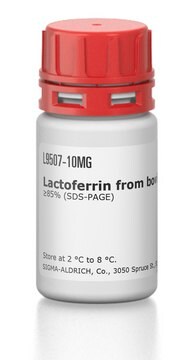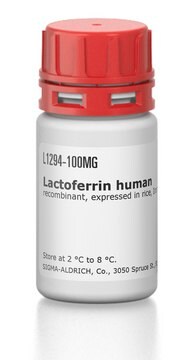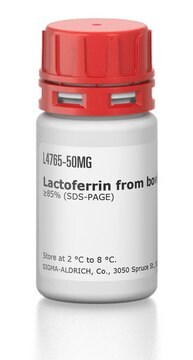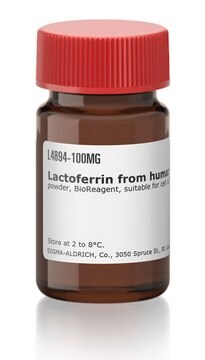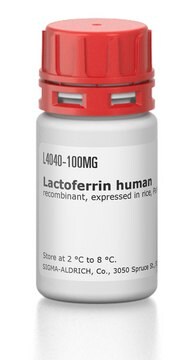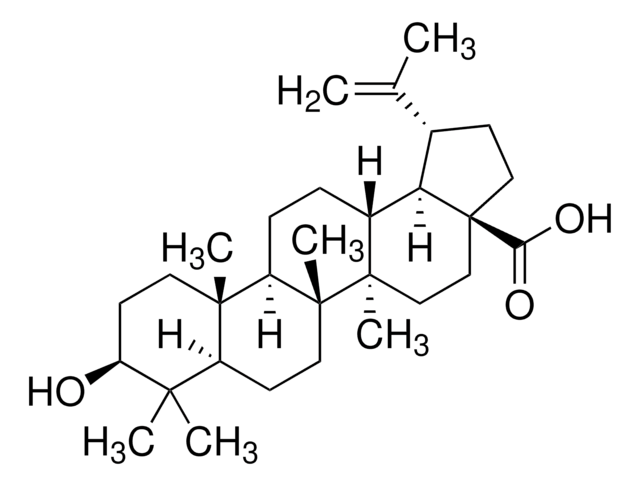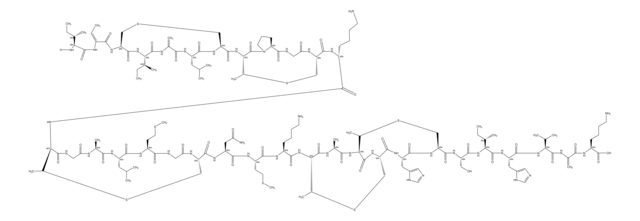L1290
Lactoferricin B, fragment 4-14 trifluoroacetate salt
≥95% (HPLC)
Synonyme(s) :
bLFC (26-36), bovine lactoferricin
Se connecterpour consulter vos tarifs contractuels et ceux de votre entreprise/organisme
About This Item
Formule empirique (notation de Hill) :
C70H113N25O13S
Poids moléculaire :
1544.87
Numéro MDL:
Code UNSPSC :
12352202
Nomenclature NACRES :
NA.32
Produits recommandés
Niveau de qualité
Essai
≥95% (HPLC)
Solubilité
H2O: soluble
Spectre d'activité de l'antibiotique
Gram-negative bacteria
Gram-positive bacteria
Mode d’action
cell membrane | interferes
Température de stockage
−20°C
Amino Acid Sequence
Arg-Arg-Trp-Gln-Trp-Arg-Met-Lys-Lys-Leu-Gly
Description générale
Chemical structure: peptide
Application
Lactoferricin B, fragment 4-14 trifluoroacetate salt has been used to study effect of lactoferricin on cell proliferation of human colon cancer cells. It has been used in study of ultraviolet light-mediated DNA damage in human colon cancer cells.
Actions biochimiques/physiologiques
Antibiotic peptide in colostrum and milk that protects from bacterial infection at mucosal surfaces.
Lactoferricin B also suppresses liver and lung metastasis in murine melanomas and lymphomas. In addition, it causes cell death in human leukemic and carcinoma cell lines. It is effective against Escherichia coli, Salmonella enteritidis, Klebsiella pneumoniae, Proteus vulgaris, Yersinia enterocolitica, Pseudomonas aeruginosa, Campylobacter jejuni, Staphylococcus aureus, Streptococcus mutans, Corynebacterium diphtheriae, Listeria monocytogenes and Clostridium perfringens.
Code de la classe de stockage
11 - Combustible Solids
Classe de danger pour l'eau (WGK)
WGK 3
Point d'éclair (°F)
Not applicable
Point d'éclair (°C)
Not applicable
Équipement de protection individuelle
Eyeshields, Gloves, type N95 (US)
Faites votre choix parmi les versions les plus récentes :
Déjà en possession de ce produit ?
Retrouvez la documentation relative aux produits que vous avez récemment achetés dans la Bibliothèque de documents.
C Freiburghaus et al.
Journal of dairy science, 92(6), 2477-2484 (2009-05-19)
Food components modify the risk of cancer at a large number of sites but the mechanism of action is unknown. In the present investigation, we studied the effect of the peptide lactoferricin derived from bovine milk lactoferrin on human colon
Liv Tone Eliassen et al.
International journal of cancer, 119(3), 493-500 (2006-03-31)
Antimicrobial peptides have been shown to exert cytotoxic activity towards cancer cells through their ability to interact with negatively charged cell membranes. In this study the cytotoxic effect of the antimicrobial peptide, LfcinB was tested in a panel of human
C Freiburghaus et al.
Journal of dairy science, 95(10), 5552-5560 (2012-08-21)
Treatment of Caco-2 cells with the peptide lactoferricin(4-14), results in reduction of the growth rate by prolongation of the S phase of the cell cycle. Lactoferricin(1-25) is formed in the gut by cleavage from lactoferrin and the bioactive amino acids
W Bellamy et al.
The Journal of applied bacteriology, 73(6), 472-479 (1992-12-01)
A physiologically diverse range of Gram-positive and Gram-negative bacteria was found to be susceptible to inhibition and inactivation by lactoferricin B, a peptide produced by gastric pepsin digestion of bovine lactoferrin. The list of susceptible organisms includes Escherichia coli, Salmonella
Notre équipe de scientifiques dispose d'une expérience dans tous les secteurs de la recherche, notamment en sciences de la vie, science des matériaux, synthèse chimique, chromatographie, analyse et dans de nombreux autres domaines..
Contacter notre Service technique